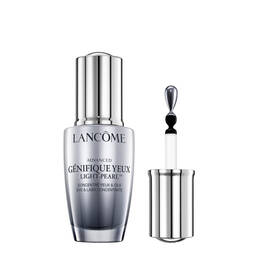Hyaluronic Acid: How and When to Use Hyaluronic Acid for Face
Discover how hyaluronic acid in skincare hydrates and plumps skin and discover how it works with Niacinamide, Glycolic Acid, Vitamin C, and Retinol.

Hyaluronic acid is a buzz-worthy skincare ingredient and one which you’ve probably come across in a skincare product or two in your beauty cabinet (it features in our star Advanced Génifique Face Serum). So, what are the benefits of hyaluronic acid for face and how does hyaluronic acid in skincare actually work? You’re about to learn more about this famed ingredient.
Hyaluronic Acid Benefits for Skin
Hyaluronic Acid for Hydration and Glow
A powerhouse hydration ingredient — hyaluronic acid is said to be the ultimate solution for retaining skin moisture.1 Recognized for its humectant properties just one molecule of hyaluronic acid is capable of holding up to 1,000 times its weight in water making it an excellent moisturizer2. With its hydration properties and ability to retain moisture the ingredient is a great addition to skincare products. For example a serum or moisturizer with hyaluronic acid for face may leave skin with a dewy, moisturized feel.3 Numerous studies have shown that hyaluronic acid in skincare improves skin hydration 4&5 and the ingredient has also been shown to improve skin roughness – often an indicator of dry skin.6
Hyaluronic Acid for Anti-Aging
Although hyaluronic acid is popular for its hydration properties, it also has some great benefits on the anti-aging front. From wrinkles to elasticity — research has shown that Hyaluronic Acid for face can have a significant improvement in the depth of wrinkles and skin elasticity & firmness – three factors often associated with aging 7&8.
Ingredient Compatibility with Hyaluronic Acid
With Hyaluronic Acid being such a popular and prominent ingredient in skincare products you may discover the ingredient in some products you use in your routine. If Hyaluronic Acid features in your go-to product you may be curious as to which ingredients you can and can’t use with Hyaluronic Acid – and which ingredient combos can help to improve certain skin concerns.
Hyaluronic Acid and Vitamin C
Whilst hyaluronic acid hydrates – Vitamin C helps to brighten the appearance of the skin and improve skin texture9 and leave with a healthy youthful glow10. A combination of visibly smooth skin and a healthy glow teamed with hydration is enough to make anyone want to use both ingredients. If you’re looking to incorporate Hyaluronic Acid and Vitamin C together into your skincare routine try looking for a product that contains both — some serums containing both ingredients have been shown to significantly increase skins moisture, decrease wrinkles, and leave skin looking brighter.11 Find Hyaluronic Acid and Vitamin C in our Rénergie H.C.F. Triple Serum which combines Hyaluronic Acid, Vitamin C+Niacinamide, and Ferulic Acid.
Retinol and Hyaluronic Acid
Retinol is typically considered an active ingredient in skincare (and often comes in specific percentages when used in skincare products) it is known for its ability to diminish the appearance of fine lines and wrinkles so the signs of aging are less visible – however it’s an ingredient that can also cause irritation in some cases12. Hyaluronic acid on the other hand (as we’ve learned) is touted for its hydration and moisturizing benefits13. As these ingredients work to target different skin concerns, retinol and hyaluronic acid are often grouped together in anti-aging formulations and the combination is one you may find in many skincare products. In terms of using the two together — it has been shown that combining retinol with other anti-aging ingredients (such as hyaluronic acid) in a skincare product can make retinol more tolerable and can have a significant improvement on the look of wrinkles, dark spots, uneven skin tone and dullness.14
Glycolic Acid and Hyaluronic Acid
Hearing two ingredients with the word “acid” in them may have you freaking out at the thought of using both in your skincare routine – but don’t worry just yet – the ingredients serve very different purposes. Whilst hyaluronic acid is all about hydration glycolic acid has a different effect in the way it targets skin. Glycolic acid is a popular ingredient labelled as an AHA exfoliant15 and is typically used to help the skin and improve skin cell turn over which helps to improve skin tone, texture and radiance16 — but when used in high concentrations it can also be harsh on the skin and increase skins photosentivity17. So poses the next question, how do they work together, and can you even use them both together? Some skincare products contain both hyaluronic acid and glycolic acid. and one study showed that a combination of hyaluronic acid and glycolic acid is more effective at boosting collagen vs glycolic acid used on its own.18
Salicylic Acid and Hyaluronic Acid
Similar to glycolic acid, the sound of two acids together may sound daunting, but much like glycolic – salicylic acid serves a different purpose. Whilst glycolic acid is an AHA exfoliant, salicylic acid is a BHA exfoliant and is typically associated with products designed to help unclog pores and exfoliate the skin and managing mild to moderate breakouts19. Salicylic Acid and Hyaluronic Acid are possible together – there are many skincare products that contain both hyaluronic acid and salicylic acid in their ingredients list. In fact — our Absolue Overnight Repairing Bi-Ampoule Concentrated Anti-Aging Serum contains a variety of different ingredients including both Hyaluronic Acid and Salicylic Acid in the formula. The Bi-Phase serum contains an essence with ingredients including Tri-Ceramides, Hyaluronic Acid, Grand Rose Extracts, Salicylic Acid and Bifidus Prebiotic and an oil with 100% pure sunflower seed oil, antioxidant-rich Vitamin E, Rose Oil.
Niacinamide and Hyaluronic Acid
Niacinamide provides some of the same benefits as the famed hyaluronic acid including boosting hydration and moisturizing the skin20 – but it also has some great results in the hyperpigmentation21 department – the ingredient has been shown to help reduce the appearance of hyperpigmentation. Where as Hyaluronic Acid is a humectant ingredient meaning it draws moisture from the skin -- Niacinamide hydrates the skin by improving the skin barrier function to increase the production of ceramides and fatty acids22. So it makes sense that using niacinamide and hyaluronic acid together can be a great option for those with ultra-dry skin looking to boost hydration. For a combination of Niacinamide and Hyaluronic Acid look to our Rénergie H.C.F. Triple Serum which contains both niacinamide and hyaluronic acid (plus Vitamin C and Ferulic Acid) and is designed to deliver optimal anti-aging benefits in one triple dose.
Lancôme Products with Hyaluronic Acid
With such great benefits it’s no surprise that hyaluronic acid features in many of Lancôme skincare products. From the number one toner worldwide – Tonique Confort — a soothing toner that improves skin hydration in just 15 minutes to our best-selling Advanced Génifique Face Serum (learn more about what is a face serum) which is designed to visibly improve the 10 key signs of aging in just one bottle (you can also find Hyaluronic Acid in our new Advanced Génifique Hydrating Eye Cream) As for the final step in your skincare routine look to Hydra Zen Glow Liquid Moisturizer — our lightweight, non-sticky moisturizer which nourishes skin with 24-hour hydration.
Our breakthrough innovation in skincare Rénergie H.C.F. Triple Serum also features Hyaluronic Acid. H.C.F. is a triple-dose serum designed to help improve volume loss, visibly reduce wrinkles & brighten dark spot appearance. The serum contains next-generation Hyaluronic Acid, the latest evolution of this ingredient designed with fragmented molecules to provide better absorption into the skin. The serum also contains some of the most known active ingredients in skincare alongside Hyaluronic Acid including Vitamin C+Niacinamide, and Ferulic Acid. With unique triple-chamber packaging three serums come together as one and the masterful combination of ingredients are designed and packaged to deliver optimal anti-aging benefits without being harsh on the skin.
1 https://www.ncbi.nlm.nih.gov/pmc/articles/PMC3970829/
2 https://www.health.harvard.edu/blog/the-hype-on-hyaluronic-acid-2020012318653
3 https://www.health.harvard.edu/blog/the-hype-on-hyaluronic-acid-2020012318653
4 https://pubmed.ncbi.nlm.nih.gov/22052267/
5 https://jcadonline.com/micronized-hyaluronic-acid-antiaging/
6 https://pubmed.ncbi.nlm.nih.gov/18384619/
7 https://pubmed.ncbi.nlm.nih.gov/22052267/
8 https://www.ncbi.nlm.nih.gov/pmc/articles/PMC3970829/
9 https://jamanetwork.com/journals/jamaotolaryngology/fullarticle/509859
10 https://www.sciencedirect.com/science/article/pii/B9780815515845500120
11 https://pubmed.ncbi.nlm.nih.gov/29881301/
12 https://www.scirp.org/journal/paperinformation.aspx?paperid=20094
13 https://www.ncbi.nlm.nih.gov/pmc/articles/PMC3970829/
14 https://www.scirp.org/journal/paperinformation.aspx?paperid=20094
15 https://www.ncbi.nlm.nih.gov/pmc/articles/PMC5172479/
16 https://www.jaad.org/article/S0190-9622(19)33164-0/abstract
17 https://www.ncbi.nlm.nih.gov/pmc/articles/PMC6017965/
18 https://www.jaad.org/article/S0190-9622(15)01145-7/fulltext
19 https://www.ncbi.nlm.nih.gov/pmc/articles/PMC5172479/
20 https://www.ncbi.nlm.nih.gov/pmc/articles/PMC2921764/
21 https://pubmed.ncbi.nlm.nih.gov/18492135/
22 https://pubmed.ncbi.nlm.nih.gov/10971324/



